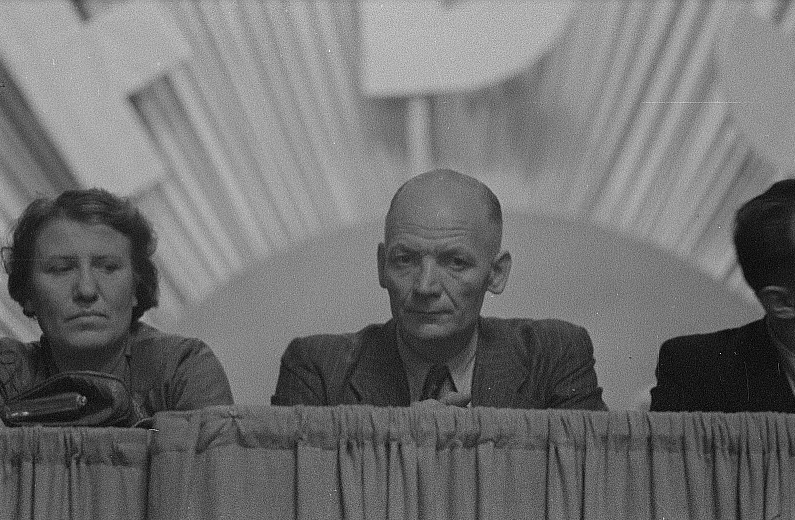Fitness to work?
Racing bikes, running shoes, yoga mats, gym memberships, these are the things that you have to have as a middle-class western individual. To finish a marathon once a year is a self-imposed obligation for every ambitious manager. Does there still remain any large company without a fitness program? After all, the health and performance of our employees is important to us.
These colossal, steel, muscular hard-grafting bodies within the visual language of “Socialist Realism” embodied the ideal of the heroic work of the “new man” for progress and communism. The hard-working, conscientious workers of General Motors, who collectively drive fordist mass production to ever greater efficiency, are hardly distinguishable from their socialist counterparts. Then, beginning in the mid-1970s, just as the post-war economic order was experiencing its first major crisis, the strong, enormous male body was replaced by the fit, ‘spandex’-wearing healthy bodies of men and women.
The first recognizable star of this new fitness movement was Jane Fonda. She sold millions of her aerobics videos and even promoted the spread of the video recorder in some way. Little by little, a new concept of man was formed once again, this time with slim, fit bodies for a new modern form of economy. The lean, agile company cannot do anything with “heavy” people. The physical inertia attributed to overweight people is directly connoted in the post-industrial economy with a lack of performance and success.
Fitness has become a principle that has transcended the physique and has also opened up the psyche (resilience, positive psychology), relationships, the economy and society. There is no slacking, no rest and no ‘enough’. Thus, fitness is inextricably linked with the compulsion for economic growth and Max Weber’s Protestant spirit of capitalism.
References:
Jürgen Martschukat: The age of fitness. How the body became a sign of success and performance
Andreas Reckwitz: The Society of Singularities
Remark to the title: “Fit mach mit” (here: Fitness to work) was the slogan of a campaign to foster a healthier lifestyle by exercise waged by the Austrian Government in the 1970.
Jane Fona Workout Videos Promo (1988) - Youtube
From Dawn to Sunset 1937, Preilinger Archives/Archive.org, Public Domain

Arbeiter und Kolchosbauern, Statue Moskau 1939
© Wikimedia Von karel291, CC BY 3.0, https://commons.wikimedia.org/w/index.php?curid=53890726
Fitness to work?
Racing bikes, running shoes, yoga mats, gym memberships, these are the things that you have to have as a middle-class western individual. To finish a marathon once a year is a self-imposed obligation for every ambitious manager. Does there still remain any large company without a fitness program? After all, the health and performance of our employees is important to us.
These colossal, steel, muscular hard-grafting bodies within the visual language of “Socialist Realism” embodied the ideal of the heroic work of the “new man” for progress and communism. The hard-working, conscientious workers of General Motors, who collectively drive fordist mass production to ever greater efficiency, are hardly distinguishable from their socialist counterparts. Then, beginning in the mid-1970s, just as the post-war economic order was experiencing its first major crisis, the strong, enormous male body was replaced by the fit, ‘spandex’-wearing healthy bodies of men and women.
The first recognizable star of this new fitness movement was Jane Fonda. She sold millions of her aerobics videos and even promoted the spread of the video recorder in some way. Little by little, a new concept of man was formed once again, this time with slim, fit bodies for a new modern form of economy. The lean, agile company cannot do anything with “heavy” people. The physical inertia attributed to overweight people is directly connoted in the post-industrial economy with a lack of performance and success.
Fitness has become a principle that has transcended the physique and has also opened up the psyche (resilience, positive psychology), relationships, the economy and society. There is no slacking, no rest and no ‘enough’. Thus, fitness is inextricably linked with the compulsion for economic growth and Max Weber’s Protestant spirit of capitalism.
References:
Jürgen Martschukat: The age of fitness. How the body became a sign of success and performance
Andreas Reckwitz: The Society of Singularities
Remark to the title: “Fit mach mit” (here: Fitness to work) was the slogan of a campaign to foster a healthier lifestyle by exercise waged by the Austrian Government in the 1970.
Jane Fona Workout Videos Promo (1988) - Youtube
From Dawn to Sunset 1937, Preilinger Archives/Archive.org, Public Domain

Arbeiter und Kolchosbauern, Statue Moskau 1939
© Wikimedia Von karel291, CC BY 3.0, https://commons.wikimedia.org/w/index.php?curid=53890726

Erwin and Elvira, the butcher
Fassbinder's outstanding melodrama "In a Year of 13 Moons" (1978) is a consistently topical contribution to today's identity politics debate and a forceful exclamation mark for anti-stereotypical professions.
The old fear of the end of new work itself
We all look forward to the end of the working day, but not the end of work itself. The fear of automation and the end of work is an old topos, as evidenced by industrial films from the 1950s.
Superpowers on the job
What to do with superhuman abilities on the job? Superheroes don't give much information on this. A troll in one of the most extraordinary Swedish films of recent years (Border, 2018), on the other hand does.
When pictures of economy went into motion
A new book introduces us to the important epistemologist Michael Polanyi as a didactician of economics and recalls his educational film "Unemployment and Money" (1940), which is still worth seeing today.
Adolf Hennecke — Hero of the Battle of Production
Where labour and the heroic merge: the glorification of labour in real socialism.
Finding and Cultivating the Self in Hair: On the Wizardry of Hairdressers
The key to successfully creating a hairstyle is, of course, the hairdresser's skill. But the art of hair is not limited to instrumental skills, it also includes the 'culturality' of hair. A contemporary critique of a traditional profession.

About this blog
By selecting a film or an image, this blog literally illustrates the vast sphere of work, employment & education in an open collection of academic, artistic and also anecdotal findings.
About us
Konrad Wakolbinger makes documentary films about work and life. Jörg Markowitsch does research on education and work. They are both based in Vienna. Information on guest authors can be found in their corresponding articles.
More about
Interested in more? Find recommendations on relevant festivals, film collections and literature here.
About this blog
With picking a film or an image, this blog literally illustrates the vast sphere of work, employment & education in an open collection of academic, artistic and also anecdotal findings.
About us
Konrad Wakolbinger makes documentary films about work and life. Jörg Markowitsch does research on education and work. We both work in Vienna. Information on guest authors can be found in their respective articles.
More about
Interested in more? Find recommendations on relevant festivals, film collections and literature here.







